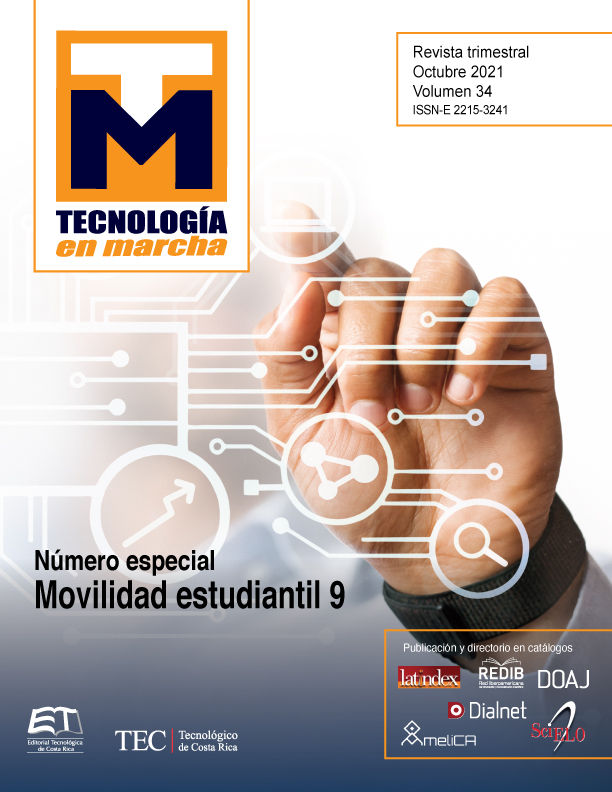Charging station to provide greater autonomy to the Robobo
Main Article Content
Abstract
Robobo is a mobile robotic platform developed by Universidade da Coruña’s MINT company. It is currently used as a tool for learning and benefit from the different advantages of autonomous and collaborative robotics at schools and investigation centers, it also can be found on the market as an educational package that includes four units. However, Robobo’s performance lacks on an autonomous, automated, homogeneous or simultaneous recharging process. Therefore, this article treats the importance and the design of a first electromechanical prototype of a charging station as an approach to obtain an autonomous and simultaneous charging cycle of up to four Robobo mobile platforms.
Article Details

This work is licensed under a Creative Commons Attribution-NonCommercial-NoDerivatives 4.0 International License.
Los autores conservan los derechos de autor y ceden a la revista el derecho de la primera publicación y pueda editarlo, reproducirlo, distribuirlo, exhibirlo y comunicarlo en el país y en el extranjero mediante medios impresos y electrónicos. Asimismo, asumen el compromiso sobre cualquier litigio o reclamación relacionada con derechos de propiedad intelectual, exonerando de responsabilidad a la Editorial Tecnológica de Costa Rica. Además, se establece que los autores pueden realizar otros acuerdos contractuales independientes y adicionales para la distribución no exclusiva de la versión del artículo publicado en esta revista (p. ej., incluirlo en un repositorio institucional o publicarlo en un libro) siempre que indiquen claramente que el trabajo se publicó por primera vez en esta revista.
References
MINT, «¿Qué es Robobo?,» [En línea]. Available: https://theroboboproject.com/que-es-robobo/. [Último acceso: 03 julio 2018].
M. Vizcaíno, «Diseño de una Base de Recarga para la Plataforma Robótica Móvil Robobo,» 2019.
Real Academia Española, «Robot».
H. Moravec, «Robot,» 2019. [En línea]. Available: https://www.britannica.com/technology/robot-technology. [Último acceso: febrero 2019].
A. Andrew, Behavior‐Based Robotics, Massachusetts: Cambridge, 1998.
GII, «DREAM: Deferred Restructuring of Experience in Autonomous Machines.,» 2018. [En línea]. Available: http://www.gii.udc.es/proyectos/detalle/342. [Último acceso: febrero 2019].
GII, «Robótica y Cognición,» 2014. [En línea]. Available: http://www.gii.udc.es/investigacion/detalle/5. [Último acceso: enero 2019].
A. Barrientos, Fundamentos de robótica, 2 ed., McGraw-Hill, 2007.
R. Aracil, C. Balaguer y M. Armanda, «Robots de servicio,» Revista Iberoamericana de Automática e Informática Industrial RIAI, vol. 5, nº 2, pp. 6-13, 2008.
E. Ruiz, Los robots en la educación, Ediciones Díaz de Santos, 2007.
L. Fernández y A. Muñoz, «Investigación sobre los Requisitos del Movimiento Colectivo Coordinado en un Sistema Multi-agente,» Revista Iberoamericana de Inteligencia Artificial, 2007.
F. Bellas, M. Naya, G. Varela, L. Llamas y e. al., «The Robobo Project: Bringing Educational Robotics Closer to Real-World Applications,» A Coruña, 2017.
MINT, «Tienda,» [En línea]. Available: https://theroboboproject.com/producto/pack-ensenanza-secundaria/. [Último acceso: 03 julio 2018].
MINT, «Robobo en la educación,» [En línea]. Available: https://theroboboproject.com/educacion/. [Último acceso: enero 2019].
MINT, «Manual de Usuario,» España.
Diodes Incorporated, «APX321/APX358/APX324,» 2009.
Linear Technology Corporation, «LTC1733 Monolithic Linear Lithium-Ion Battery Charger with Thermal Regulation.,» USA.
E. Olson, «AprilTag: A robust flexible visual fiducial system,» University of Michigan, 2011. [En línea]. Available: https://ieeexplore.ieee.org/document/5979561. [Último acceso: 10 setiembre 2018].
J. Wang y E. Olson, «AprilTag 2: Efficient and robust fiducial detection,» Michigan, Estados Unidos, 2016.
MINT, «Especificaciones,» España.

